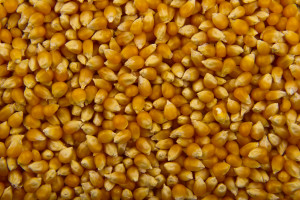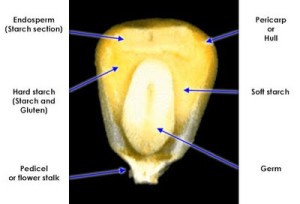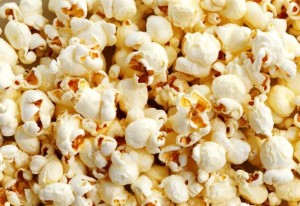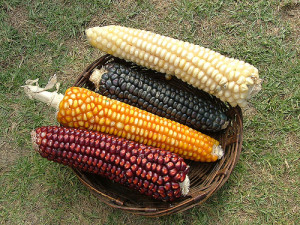As I’m sitting here thinking about a topic for my blog and late night snacking on a bag of popcorn, I began to wonder how this small bag of kernels became a delicious bag of perfectly popped popcorn. By laying the bag a certain way in the microwave and hitting the “popcorn” button you have a tasty snack in just a few minutes. How does this happen? What happens during those minutes?

Scientifically popcorn is referred to as Zea mays everta. It is a whole grain and contains three components: the germ, endosperm, and pericarp. There are four different types of corn, but only popcor n pops. This is due to the thickness of the pericarp or hull which allows the kernels to pop open. The pericarp is the outer shell of the popcorn kernel. Inside of it is the germ, and next to the germ is the endosperm which contains stored water and granules.
n pops. This is due to the thickness of the pericarp or hull which allows the kernels to pop open. The pericarp is the outer shell of the popcorn kernel. Inside of it is the germ, and next to the germ is the endosperm which contains stored water and granules.
Inside of each kernel there is a small amount of water inside of the soft starch. When the kernel begins to heat up the water starts to expand inside of the starch. As it reaches 212 degrees the water turns into steam and the starch becomes hot and sticky. The hull breaks open and the popcorn begins to pop at about 347 degrees. The popcorn will only pop when the pressure reaches 135 pounds per square inch. As it bursts open steam is released and the soft starch inflates and cools into its delicious shape.
soft starch. When the kernel begins to heat up the water starts to expand inside of the starch. As it reaches 212 degrees the water turns into steam and the starch becomes hot and sticky. The hull breaks open and the popcorn begins to pop at about 347 degrees. The popcorn will only pop when the pressure reaches 135 pounds per square inch. As it bursts open steam is released and the soft starch inflates and cools into its delicious shape.
About 18 billion quarts of popcorn are consumed each year in the United States, which means about 56 quarts per pe rson! Many nutritionists state that popcorn is a good snack to eat since it contains fiber, is low in fat and is a whole grain. Popcorn is also loaded with protein and is a great snack for someone who is on a diet. Plain air popped popcorn is sugar free, and low in calories. Its also gluten free!
rson! Many nutritionists state that popcorn is a good snack to eat since it contains fiber, is low in fat and is a whole grain. Popcorn is also loaded with protein and is a great snack for someone who is on a diet. Plain air popped popcorn is sugar free, and low in calories. Its also gluten free!
Sources:
http://www.popcorn.org/ForTeachers/TeachingGuide/WhatMakesPopcornPop/tabid/88/Default.aspx
http://www.carolina.com/teacher-resources/Interactive/the-science-of-popcorn/tr23952.tr
http://www.livescience.com/49768-mechanics-of-popcorn.html
http://chemistry.about.com/od/foodcookingchemistry/f/how-popcorn-pops.htm


I really liked your topic of choice. It things like this that we have always done but never know the science behind it. I never would have thought that there could have been water in the popcorn! 18 billion quarts of popcorn really is a lot, and its really nice that it is loaded with protein and fibers.
This was a very unique topic that you chose. Often times when I’m standing next to the microwave, trying to get that perfect bag of popcorn I think of how little kernels turn into fluffy popcorn, and you just gave me the answers. I often have considered running my own trials to find the perfect power and time combination to (on average) come to the perfect bag of popcorn. One thing that my mom always does is to use water and a bowl, just like it says to in that link.
This was very clever of you to think about posting a blog on popcorn because I feel that it is interesting and something that most people love. It was interesting to me that there are 4 different types of corn and only 1 of them actually pop. In addition, I also can’t believe that 18 billion quarts of popcorn are consumed in the United States each year. That’s a lot of popcorn.. also after reading your blog, I am now craving popcorn at this late hour! I also never knew that popcorn was loaded with protein. That’s definitely something that I will keep in mind when I indulge in a bag in the near future. I hope your popcorn is good and your blogs are going well. I may just have to head over to Good to Go tomorrow to get myself a bag!